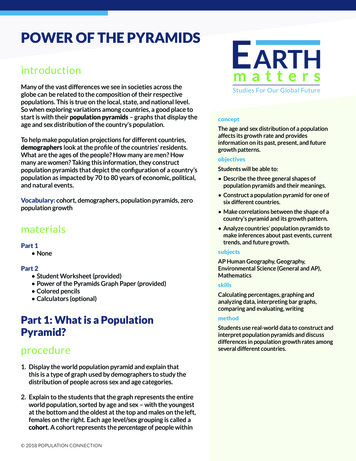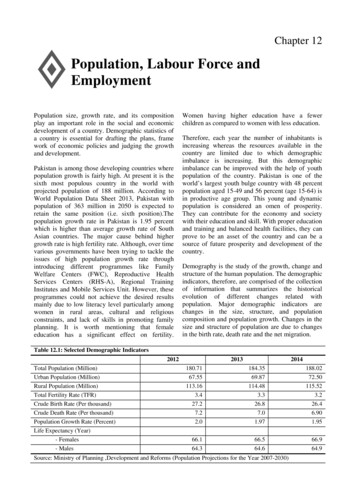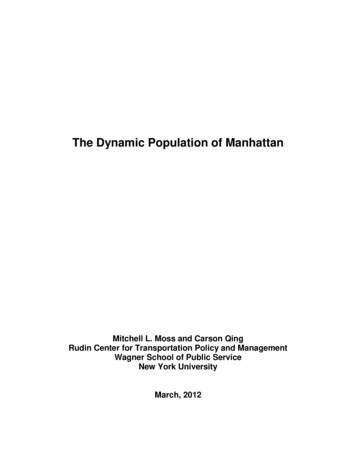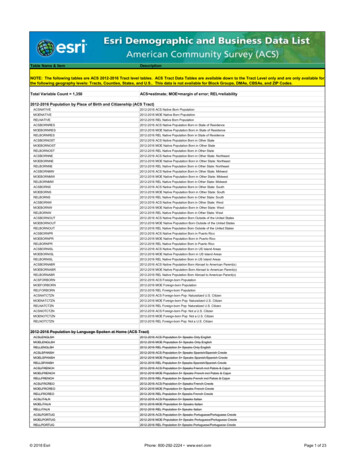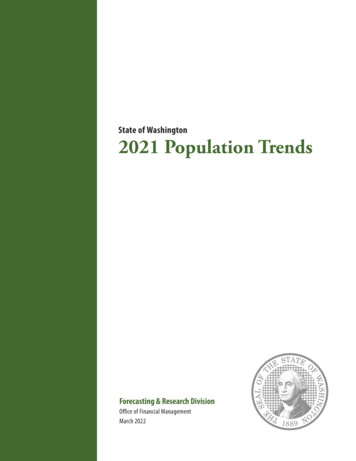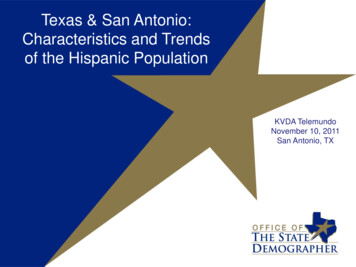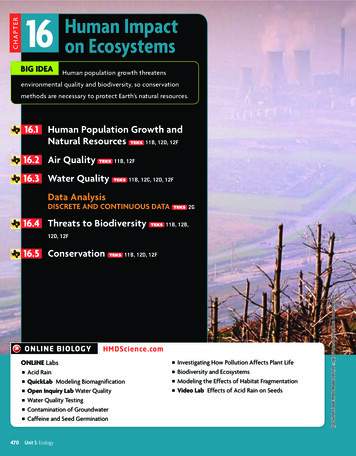
Transcription
CHAPTER16Big IdeaHuman Impacton EcosystemsHuman population growth threatensenvironmental quality and biodiversity, so conservationmethods are necessary to protect Earth’s natural resources.16.1 Human Population Growth andNatural Resources11B, 12D, 12F16.2 Air Quality11B, 12F16.3 Water Quality11B, 12C, 12D, 12FData Analysisdiscrete and continuous data16.4 Threats to Biodiversity2G11B, 12B,12D, 12FOnline Biology11B, 12D, 12FHMDScience.comONLINE LabsAcid Rain QuickLab Modeling Biomagnification Open Inquiry Lab Water Quality Water Quality Testing Contamination of Groundwater Caffeine and Seed Germination 470Unit 5: EcologyInvestigating How Pollution Affects Plant Life Biodiversity and Ecosystems Modeling the Effects of Habitat Fragmentation Video Lab Effects of Acid Rain on Seeds (t) Simon Fraser/Photo Researchers, Inc.; (br) Thomas Nilsen/Photo Researchers, Inc.16.5 Conservation
QWhat happenedto this forest?This once lush hillside has beendestroyed by acid rain. Emissionsfrom a nearby steel plant releasechemical compounds that changethe natural pH of rain, forming acidrain. Not only does acid rain damageleaves and branches, but because itlowers soil pH, it can damage plantroot systems and kill useful microorganisms that release nutrientsfrom dead organic material.R EADI N G T o o lb o xThis reading tool can help you learn the material in the following pages.USING LANGUAGEFinding Examples Concrete examples often helpclarify new information. Certain words and phrases canhelp you recognize examples. These words include forexample, such as, like, and including.Your TurnUse what you have learned about examples to answer thefollowing questions.1. Find the examples in the following sentence: TheBurmese python feeds on small animals such as rats,birds, raccoons, and even dogs.2. Find the examples in the introductory paragraph ofthis reading tool.Chapter 16: Human Impact on Ecosystems471
16.1 Human Population Growth and NaturalResources11b, 12d, 12fAs the human population grows, the demand forEarth’s resources increases.Key ConceptVOCABULARYMAIN IDEASnonrenewable resourcerenewable resourceecological footprintEarth’s human population continues to grow.The growing human population exerts pressure on Earth’s natural resources.Effective management of Earth’s resources will help meet the needs of the future.11B investigate andanalyze how organisms, populations,and communities respond toexternal factors; 12D recognize thatlong-term survival of species isdependent on changing resourcebases that are limited; 12F describehow environmental change canimpact ecosystem stabilityConnect to Your WorldHumans depend upon Earth’s nutrient and energy cycles. We harness Earth’s energyto power our televisions, radios, streetlights, automobiles, airplanes—and everythingelse in our homes and cities. Your cotton T-shirt and this paper page came fromplants that depend on Earth’s nutrient cycles. The water you drink comes from watersources replenished by the hydrologic cycle. We do not just use Earth’s cycles, we area part of Earth’s cycles. Everything we eat, drink, and use comes from Earth. But theoveruse of resources and the production of waste can cause disruptions in theenergy and nutrient cycles of Earth.MAIN IDEA12D, 12FEarth’s human population continues to grow.How many people can Earth support? In other words, what is the carryingcapacity for humans on Earth? Recall that carrying capacity refers to themaximum population size that an environment can consistently support.Earth’s Carrying CapacityFigure 1.1 World Population10ActualProjectedPopulation (billions)86420115013501550Year175019502150Source: United Nations, World PopulationProspects, Population Reference Bureau472Unit 5: EcologyOur predictions of Earth’s human carrying capacity have changedover time. In the late 1700s, a young economist named ThomasMalthus wrote a controversial essay in which he claimed that thehuman population was growing faster than Earth’s resourcescould support. Today, scientists use his observations and predic tions when they are describing the concept of an ecosystem’scarrying capacity. In Malthus’s lifetime, the world population wasaround 1 billion. The graph in FIGURE 1.1 shows how populationsize has changed over time. Today’s human population of morethan 7 billion has exceeded many earlier predictions. In thefuture, will Earth support 10 billion people, 20 billion, or even50 billion people? Although we do not know of a fixed limit to thenumber of people that Earth can support, some limit must exist—Earth cannot support an infinite number of people.
Technology and Human PopulationRecall that the carrying capacity of an environment can change as the envi ronment changes. As humans have modified their environment throughagriculture, transportation, medical advances, and sanitation, the carryingcapacity of Earth has greatly increased.Technologies developed by humans have allowed Earth to support morepeople than Malthus could ever have imagined. Motorized farm equipment,made possible the production of much more food than could be produced byhuman and animal power. Medical advances have also contributed to popula tion growth. For example, infant mortality rates in the United States havedropped steadily over the last 70 years. In 1940, more than 40 infants died forevery 1000 births. In 2002, only 7 infants died per 1000 births. Antibiotics andantiseptics have lowered infant mortality and the spread of diseases.For a moment, think about how much we depend on technology. Howhave human lives changed with the help of plumbing to bring fresh water intohomes and to take human waste out of homes? What if there were no trans portation to move food and materials around the globe? What if there wereno medicines? How many people could Earth support without electricity orgas, or if all construction had to be done by hand? Technological advanceshave allowed for continued human population growth.R E A D I N G TO O L B oxTAKING NOTESUse a diagram to summarizehow technology has helped thehuman population grow.TechnologyMedicineConnect What technologies do you depend on each day?MAIN IDEA12D, 12F Alan Sirulnikoff/Photo Researchers, Inc.The growing human population exerts pressureon Earth’s natural resources.Two resources, oil and coal, currently support the majority of our country’senergy use. Oil and coal are the result of natural processes. Over millions ofyears, natural processes transformed dead organisms into the concentratedcarbon substances we use today as oil and coal. Oil and coal arenonrenewable resources because they are used faster than the rate at whichthey form. In 2006, the human population was using oil at a rate of about 77million barrels per day, and world oil use continues to rise. The growing useof this limited resource will lead to energy crises in the decades ahead unlesstechnologies are developed to use other forms of energy.Not all resources are nonrenewable. A natural resource that can be re placed at the same rate at which it is used is called a renewable resource. Forexample, wind energy—captured by wind turbines such as those shown infigure 1.2—and solar energy are renewable resources because they cannot beused up by humans. Other resources, such as those that come from plantsand animals, can be used up, but because they could last indefinitely throughregrowth and reproduction, they are renewable. As long as these resourcesare replenished faster than they are used, they are considered renewable. Butif renewable resources are not used carefully, they can become nonrenewable.FIGURE 1.2 Giant wind turbinessuch as these capture renewableenergy from Earth’s naturalprocesses.Chapter 16: Human Impact on Ecosystems473
CONNECT TOHydrologic CycleIn the chapter Principles ofEcology, you learned how thehydrologic cycle moves waterthrough Earth’s atmosphere andback to Earth’s surface. Thiscycling of water from resourcessuch as lakes, rivers, and aquiferssustains the needs of thesurrounding ecosystem.Drinking water is a renewable resource, but pollution and overuse threatenits supply. Pesticides, industrial waste, and other contaminants have beenfound in water sources that supply tens of millions of people across theUnited States with fresh water. Groundwater is also being extracted fromaquifers faster than it is replaced.As Earth’s human population continues to grow, the management ofrenewable and nonrenewable resources will become increasingly important.Today, the United States uses more resources and produces more waste thanany other country on Earth. Each year, the United States generates about 230million tons of garbage. That is about 4.2 pounds per day, per person, oralmost 1 ton per year. What would happen if each of Earth’s 7 billion humansgenerated 1 ton of garbage each year?Analyze Explain how a renewable resource such as water could become anonrenewable resource.MAIN IDEA11b, 12D, 12FFIGURE 1.3 Today, the barrenlandscapes of Easter Island are aneerie reminder of the fate of theisland’s ancient inhabitants.474Unit 5: EcologyManagement of Earth’s resources affects both current and future generations.The responsible use of Earth’s resources can help to maintain these resourcesfor future generations.The story of Easter Island is a cautionary tale of destruction caused bycareless use of resources. When humans first landed on Easter Island between400 CE and 700 CE, it was thickly forested on rich soil, with many birdspecies. The human colony grew quickly over the next 1000 years, building thestone monuments for which the island is now famous. The inhabitants cutdown the forests for lumber and for building boats. The trees were cut downfaster than they could grow back. Eventually,Easter Island was left with no trees, as shown infigure 1.3. Without trees, there was no wood forshelter or boats, the rich soil washed away, andhabitat for the island’s animal populations waslost. Without boats, there was no offshorefishing. Without food and island resources nearlygone, the Easter Island human populationcrashed and the Easter Islanders disappeared.The Easter Islanders’ use of trees was unsus tainable. In other words, the islanders used treesto meet their short-term needs. But this resourcecould not be maintained into the future, and itsuse had negative long-term effects. In contrast,sustainable use of resources means using re sources in such a way that they will be availablefor future generations. Bill Bachmann/Alamy ImagesEffective management of Earth’s resources willhelp meet the needs of the future.
Ecological FootprintAverage Ecological Footprints by RegionPopulation (millions)Ecological footprint(hectares per person)Humans need natural resources to survive, but104000Population (millions)the way resources are used threatens the welfare of9Ecological footprintthe human population. Earth’s carrying capacity83000depends on how much land is needed to support7each person on Earth. The amount of land neces 6sary to produce and maintain enough food and52000water, shelter, energy, and waste is called an4ecological footprint. The size of an ecological31000footprint depends on a number of factors. These2include the amount and efficiency of resource use,1and the amount and toxicity of waste produced.00As shown in figure 1.4, individuals and popu North Europe Middle Central Asia AfricaAmericaEastandPacificlations vary in their use of resources and produc SouthAmerication of waste, and therefore in the size of theirecological footprints. The average U.S. citizen’sSource: Global Footprint Networkecological footprint covers an area larger than 24 football fields (9.7 hectares)FIGURE 1.4 Different regions ofand is one of the largest in the world. But the ecological footprint of individ the world have varying levels ofuals in developing nations is growing, and nations such as China and Indiaimpact on their environment. Thishave populations that are more than three times the size of the U.S. popula graph shows the average ecological footprint of individuals aroundtion. Individuals in the United States may have a large footprint, but otherthe world.nations have a lot more “feet.”As the world population continues to grow, we face many challengingdecisions. Waste production and management is an issue that will becomemore important as we move into the future. Should we have rules to regulateresource use and waste production? If so, how much resource use and wasteproduction should individuals and populations be allowed? How much landneeds to be maintained for agriculture, how much for living space, and howmuch for other uses? How much fresh water should be used for crop irrigationand how much reserved for humans to drink? Our welfare, and the welfare offuture generations, depends on sustainable management of Earth’s resources.Analyze Why is our ecological footprint related to an area of land?Self-check OnlineHMDScience.com16.1GO ONLINEFormative AssessmentCONNECT TOCritical thinkingCarrying Capacity1. Give three examples of howtechnology has influenced humanpopulation growth.4. Connect What factors can limit thegrowth of the human population?2. What is the difference betweenrenewable and nonrenewableresources?5. Synthesize How could the EasterIslanders have prevented their12Dpopulation crash?6. The progressive increase inEarth’s human carryingcapacity came from advancesin technology. What densityindependent and densitydependent limiting factorsmay prevent the humanpopulation from continuedgrowth?11bReviewingMain Ideas3. Describe how a population can useresources in a sustainable way.11bChapter 16: Human Impact on Ecosystems475
16.2 Air Quality11b, 12fFossil fuel emissions affect the biosphere.Key ConceptMAIN IDEASVOCABULARYpollutionsmogparticulateacid raingreenhouse effectglobal warming11B investigate and analyzehow organisms, populations, andcommunities respond to externalfactors and 12F describe howenvironmental change can impactecosystem stability Pollutants accumulate in the air.Air pollution is changing Earth’s biosphere.Connect to Your WorldFossil fuels are an important part of modern society. Consider that every time youride in a car, you are being transported by energy that originally came from the sun.This energy was absorbed by ancient organisms and stored in their biomass. Today, ashumans burn these fuels in the form of gas and oil, we are creating compounds thatpollute Earth’s biosphere. Without this energy our lives would be very different, buthow does air pollution from fossil fuels affect the biosphere?Main Idea11B, 12FPollutants accumulate in the air.FIGURE 2.1 The hazy fog over thecity of Los Angeles is largely produced by automobile emissionsand industrial processes. Smog is agrowing problem in many areas ofthe United States.Although it is sometimes easy to forget, humans are an important part ofthe biosphere. Our actions have direct and indirect effects on Earth’s naturalcycles. Each year humans add synthetic chemicals and materials to the Earth.Many of them cannot be integrated into normal ecosystem functions. Theaddition of these materials to the environment is called pollution. Pollutiondescribes any undesirable factor, or pollutant, that is added to the air, water, orsoil. Pollution can take the form of microscopic air particles, or waste productsfrom factories and sewers, or household chemicals that are poureddown the kitchen sink. The harmful effects of pollutants can beimmediate or delayed, but these effects may add up over time andcan disrupt the function of ecosystems.The most common air pollution comes from the waste productsproduced by burning fossil fuels such as gas and oil. Chemicalcompounds released through this process can combine to form ahaze of matter called smog, shown in figure 2.1. Smog is a type ofair pollution caused by the interaction of sunlight with pollutantsproduced by fossil fuel emissions. There are several componentsof smog, including particulate matter and ground-level ozone.Particulates are microscopic bits of dust, metal, and unburnedfuel, 1–10 microns in size, that are produced by many industrialprocesses. Once in the air, some particulates may stay in theatmosphere for weeks before they settle to the ground. Fineparticulates can be inhaled and can cause many types of healthproblems.476Unit 5: Ecology Nik Wheeler/CorbisSmog and Ozone
The second component of smog is ground-level ozone. In the presenceof sunlight, two types of chemicals react to produce ground-level ozone (O3).Nitrogen oxides are produced during fossil fuel combustion, and thesechemicals give smog a yellowish color. Ozone is formed when nitrogendioxide (NO2) reacts with oxygen (O2) present in the atmosphere. In thisreaction, one oxygen from an NO2 molecule is transferred to an O2 molecule,forming ozone (O3). The ozone produced by reactions of nitrogen oxide andoxygen tends to stay close to the ground, where it can be harmful to humanhealth and ecosystem functions. Although ozone is harmful to organisms, italso plays an important, protective role in the Earth’s upper atmosphere. Highconcentrations of ozone in the stratosphere, also known as the ozonosphereor ozone layer, act as a shield protecting Earth’s biosphere against harmfulultraviolet rays found in sunlight. Adam Hart-Davis/Photo Researchers, Inc.Acid RainThe chemicals produced by theVISUAL VOCABburning of fossil fuels become partAcid rain is a type of precipitationof the ecosystem and can changeproduced when pollutants in thewater cycle cause rain pH to dropthe products of natural cycles. Forbelow normal levels.example, nitrogen oxides and sulfuroxides from fossil fuel emissions canAcid rainNormal rainpH 4.6pH 5.6lead to the formation of acid rain.Acid rain is a type of precipitationH ionsproduced when pollutants in thewater cycle cause rain pH to dropbelow normal levels.During the water cycle, rain falls through Earth’s atmosphere and interactswith carbon dioxide molecules. As it falls, water molecules react with carbondioxide molecules to form a weak carbonic acid, which then breaks apart,leaving lone hydrogen ions. This is normal. All rain that falls is slightly acidic,with a pH around 5.6. When pollutants such as nitrogen oxides and sulfuroxides become a part of the water cycle, acid rain is the result. Reactionsbetween these chemicals and the oxygen and water normally present in theatmosphere create sulfuric and nitric acids that can cause pH levels to fallbelow 5.6.Acid rain falls in many areas of the UnitedStates and has a major effect on ecosystems. Bydecreasing pH levels in lakes and streams, acidrain threatens water supplies and species habitat.Acid rain can cause a decline in growth rates, asshown in figure 2.2. It can also cause leaves andbark to break down more quickly and make treesmore vulnerable to disease and weather.CONNECT TOpHRecall from the chapterChemistry of Life that pH is ameasure of the concentration ofH ions in a solution. Theconcentrations of H ions in acidrain are very high, giving the raina lower pH level.FIGURE 2.2 The wide growthrings of this tree indicate a healthyenvironment. The smaller growthrings illustrate how acid raindirectly impacts plant growth.Synthesize As the human population continues toincrease and use more fossil fuels, why might acidrain become a bigger problem?Chapter 16: Human Impact on Ecosystems 477
Main Idea11B, 12FAir pollution is changing Earth’s biosphere.World Temperature Change200100400300200100Thousands of years agoSource: Petit, J.R., et al., Nature 387:359.FIGURE 2.3 Scientists havefound that changes in Earth’stemperature correspond withfluctuations in global carbondioxide levels.478Unit 5: Ecology0-8-10Temperature variation ( C)CO2 concentration (ppm)300Earth’s atmosphere naturally includes molecules of carbon dioxide that play animportant part in keeping the biosphere at a temperature that can support life.The levels of atmospheric carbon dioxide rise and fall over time as a normalpart of the climate cycles of Earth. Collections of datafrom arctic ice cores allow scientists to look deep intoEarth’s atmospheric history. They have discovered that10cycles of rising and falling carbon dioxide levels followTemperatureCO28known patterns of periodic warming and cooling.6The relationship between changes in global average4temperatures and carbon dioxide levels is shown in2FIGURE 2.3. We know that high levels of carbon dioxide0are typical of Earth’s warmer periods, while low levels-2are associated with cool climates, eventually leading to-4periods of extreme cold called ice ages.-6The Greenhouse EffectEarth gets nearly all of its energy from the wavelengthsof both visible and invisible light emitted by the sun.When the sun’s waves reach Earth, some are absorbedby Earth’s atmosphere, but many of these rays passthrough the atmosphere and reach Earth’s surface. Some of this energy isabsorbed by Earth’s surface, but it is later reradiated as invisible infraredradiation—energy in the form of heat. After being reradiated from Earth’ssurface, this energy could travel away from Earth, be lost into space, and leavean extremely cold Earth that could never sustain life. But Earth is not cold anddoes have life. So what keeps Earth’s temperature from dropping to extremefreezing conditions?To answer this question, think about the greenhouses that scientists andgardeners use to grow plants. Greenhouses use glass that allows light andradiation from sunlight to pass through and provide energy for plant growth.The glass also prevents infrared radiation from escaping. This infrared radiation keeps the inside of the greenhouse warm. This same phenomenon occursin a car, causing the inside to warm when the windows are closed.In the same way that greenhouse glass creates an environment for plantsto grow, the chemical composition of Earth’s atmosphere plays an importantrole in maintaining an environment that is suitable for life. Earth’s atmospherecontains gases called greenhouse gases that act as insulators and slow the lossof heat through the atmosphere. Water vapor, carbon dioxide, and methaneare three of the most common greenhouse gases found in the atmosphere.Greenhouse gases absorb wavelengths of infrared radiation. This process iscalled the greenhouse effect and is illustrated in figure 2.4. Thegreenhouse effect occurs when carbon dioxide, water, and methanemolecules absorb energy reradiated by Earth’s surface and slow the releaseof this energy from Earth’s atmosphere.
FIGURE 2.4 Greenhouse EffectWater vapor, carbon dioxide, and methane can be found all throughEarth’s atmosphere. These greenhouse gases act as a blanket thatslows the release of energy and helps to keep Earth at a temperaturethat can support life.31Short, high-energywavelengths of lightemitted from the sunpenetrate Earth’satmosphere.2Greenhouse gasesin the atmosphereabsorb many of thelonger wavelengths ofinfrared radiation.carbon dioxide (CO2)methane (CH4)Energy from the sun isabsorbed by Earth andreradiated as infraredradiation, or heat.4water (H2O)The molecules rereleaseinfrared radiation, whichis absorbed again byother molecules, Earth’ssurface, or is lost inouter space.Global WarmingCO2 concentration (ppm)(bl) Dennis MacDonald/Alamy Images; (background) G. Baden/zefa/Corbis370Global Temperature And CarbonDioxide Levels Over 320-0.1531030019601970Year19801990Temperature variation ( C)As automobile use and industry have grown, so have thelevels of carbon dioxide and other greenhouse gases in theatmosphere. This graph shows average global temperaturechanges (blue) against atmospheric carbon dioxide levels(green) measured at Mauna Loa Observatory in Hawaii.-0.30Source: University of California, Scripps Institute of Oceanography/Hadley Centre for Climate Prediction and ResearchCRITICAL How would an increase in atmospheric greenhouse gases contribute to an12FVIEWING increase in average global temperatures?479
North PoleSummer Arctic Seaice boundary in 1979FIGURE 2.5 Over the past20 years, increasing globaltemperatures have decreasedsummer ice pack around theNorth Pole by about 20 percent.HMDScience.comGO ONLINECarbon Dioxide andGlobal WarmingClimate ChangeOver the past 100 years, the average globaltemperature has risen 0.74 C (1.3 F), with themost dramatic change occurring over the past 50years. What is causing this rise in temperature?Global temperature fluctuations are a normalpart of Earth’s climate cycle. But major changes intemperature generally occur over tens of thousands of years, not over 100 years.The trend of increasing global temperaturesis known as global warming. From a variety ofevidence, scientists can infer that the changes intemperature are the result of increased levels ofgreenhouse gases such as carbon dioxide, water, and methane. There is nodoubt that the growth of industry and use of automobiles has increased theemission of greenhouse gases over the past 100 years. Scientists may disagreeon how much this human impact is influencing the warming trend, but mostagree that we must take steps to slow the process.Scientists do not know how these atmospheric changes will affect theglobal biosphere. What they do know is that evidence shows climate change isalready threatening ecosystems around the world. Ecological disasters, such asincreased flooding, stronger tropical storms, and the loss of biodiversity, arejust a few of the threats that may be caused by climate change. As shown infigure 2.5, the polar ice pack is melting at a rapid pace, which may eventuallyaffect global weather patterns. These changes may be part of a slow warmingprocess, or they may be the beginning of a rapid global climate change. Thefuture of climate change is uncertain, but scientists predict that averagetemperatures on Earth could increase anywhere from 1.1 to 6.4 C (2 to 11.5 F)by the year 2100, a change that could have dramatic effects on Earth’s biosphere, and change the planet that we call home.Connect How might climate change affect seasonal temperature changes?NASA12FSelf-check OnlineHMDScience.com16.2ReviewingMain Ideas1. Name and describe two ways inwhich pollution affects ecosystems.11B, 12F2. How does the greenhouse effectkeep Earth warm?3. Explain how a build-up of carbondioxide in the atmosphere couldincrease Earth’s global temperature.480GO ONLINEFormative AssessmentUnit 5: EcologyCritical thinking4. Predict Describe how acid rainfalling in a forest could disrupt thetrophic structure of the ecosystem.11B, 12F5. Connect Name two importantfunctions of greenhouse gases atEarth’s surface.CONNECT TOFood Webs6. Ocean producers suchas phytoplankton are animportant part of food webs,but they need a specifictemperature to survive.How might increased watertemperatures affect these12Cocean food webs?
G!enilnOACarbon Dioxide andGlobal Warming Analyzecarbon dioxide levels onEarth over time.!That’s z ingm a Video InquiryKiller Kitties hat happens when house cats goWwild? Find out how they can disruptthe balance of an ecosystem, and learnabout how we can fix the problem.BIOLOGYHuman Effects on a FoodWeb Apply a humaninduced change to a foodweb and see how thechange ripples through thesystem.online biology 481HMDScience.com
16.3 Water Quality11B, 12C, 12D,12FVOCABULARYindicator speciesbiomagnification11B investigate andanalyze how organisms, populations,and communities respond toexternal factors; 12C analyze theflow of matter and energy throughtrophic levels using various models,including food chains, food webs,and ecological pyramids;12D recognize that long-termsurvival of species is dependent onchanging resource bases that arelimited; 12F describe howenvironmental change can impactecosystem stability.Key Concept Pollutionof Earth’s freshwater supply threatenshabitat and health.MAIN IDEASWater pollution affects ecosystems.Biomagnification causes accumulation of toxins in the food chain.Connect to Your WorldWhen you swallow a pill, your body only uses a part of the medicine in the pill andgets rid of the rest as waste, which is flushed away. Scientists have detected traces ofmany prescription drugs in freshwater supplies. Several fish species that live in freshwaters have been exposed to the female hormone estrogen. Some of the male fishhave begun showing female characteristics. These “gender-bending” fish are only oneeffect of water pollution. What other pollutants can be found in our water?MAIN IDEA11B, 12D, 12FBiologyVIDEO C L I PHMDScience.comGO ONLINEHuman Impact, WaterPollutionFIGURE 3.1 A buildup of algae inlakes such as this one is the directresult of pollution. Eventually, theprocess of eutrophication will leadto the disappearance of the lake.482Unit 5: EcologyPollution can have a major impact on water ecosystems. Chemical contaminants, raw sewage, trash, and other waste products are only a few pollutantsthat make their way into rivers, lakes, and aquifers all over the world.Runoff from farms and cities may contain toxic chemicals and debris thatcan disrupt the chemical balance of freshwater lakes and streams and put entirefreshwater ecosystems at risk. For example, detergents and fertilizers used in fieldscan affect a lake ecosystem by stimulating plant and algae overgrowth. A buildupof algae, such as the one shown in figure 3.1, can drastically lower the levels ofdissolved oxygen, leading to the dying off of fish populations. A lack of oxygen canalso keep detritivores from breaking down waste materials. Over time, lakes andponds slowly begin to fill in through a process called eutrophication.One way in which scientists can determine the health of anecosystem is through the study of natural indicator species. Anindicator species, also known as a bioindicator, is a species thatprovides a sign, or indication, of the quality of the ecosystem’senvironmental conditions. The gender-bending fish discussedabove is an example of an aquatic indicator species. Frogs aresometimes considered an indi
HMDScience.com GO ONLINE ReVIeWING MAIN IDeAS 1. Give three examples of how technology has influenced human population growth. 2. What is the difference between renewable and nonrenewable resources? 3. Describe how a population can use resources in a sustainable way. CRItICAL tHINKING 4. Connect What factors can limit the growth of the human .


